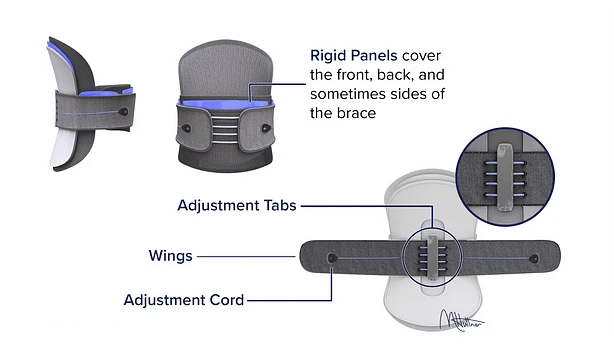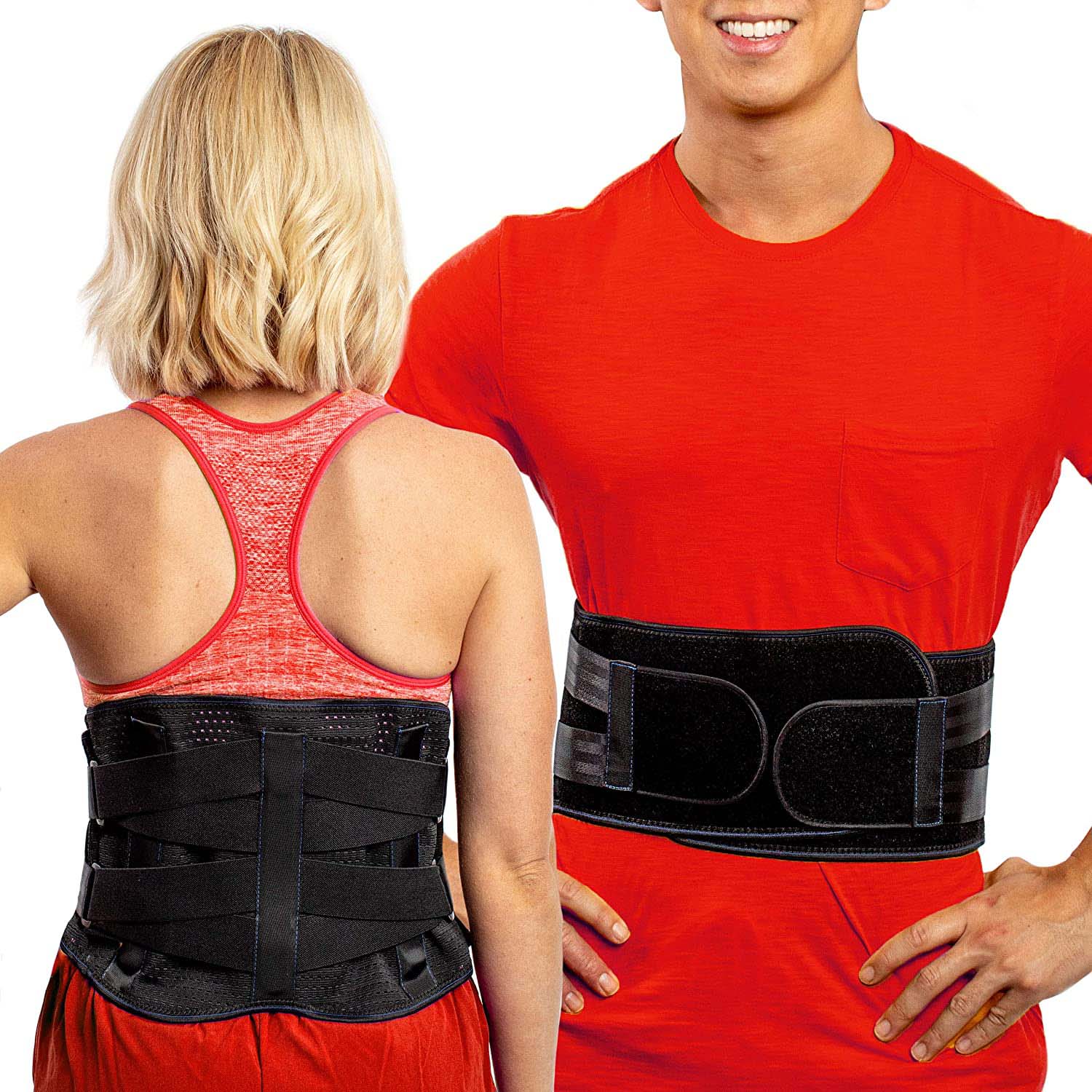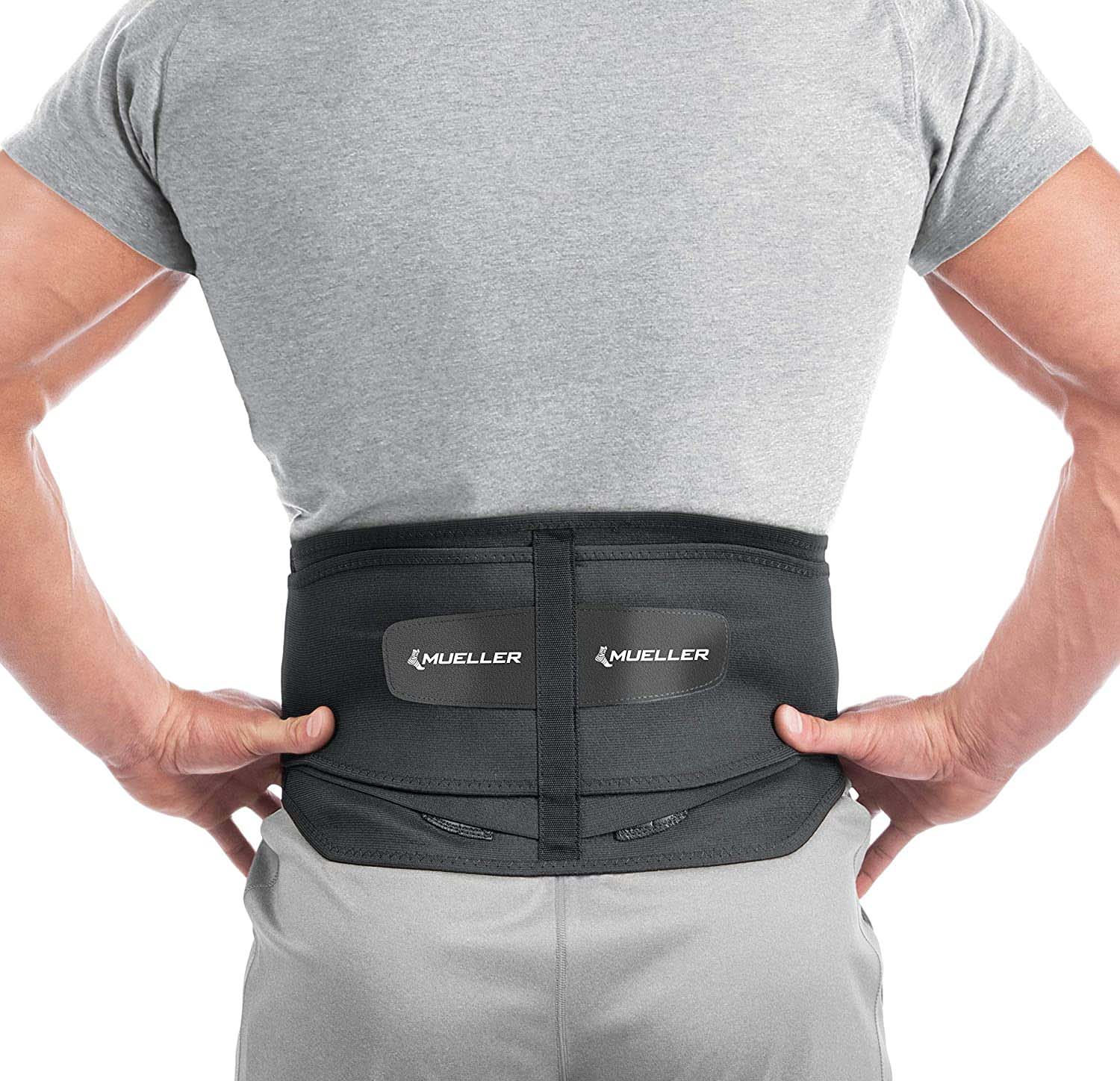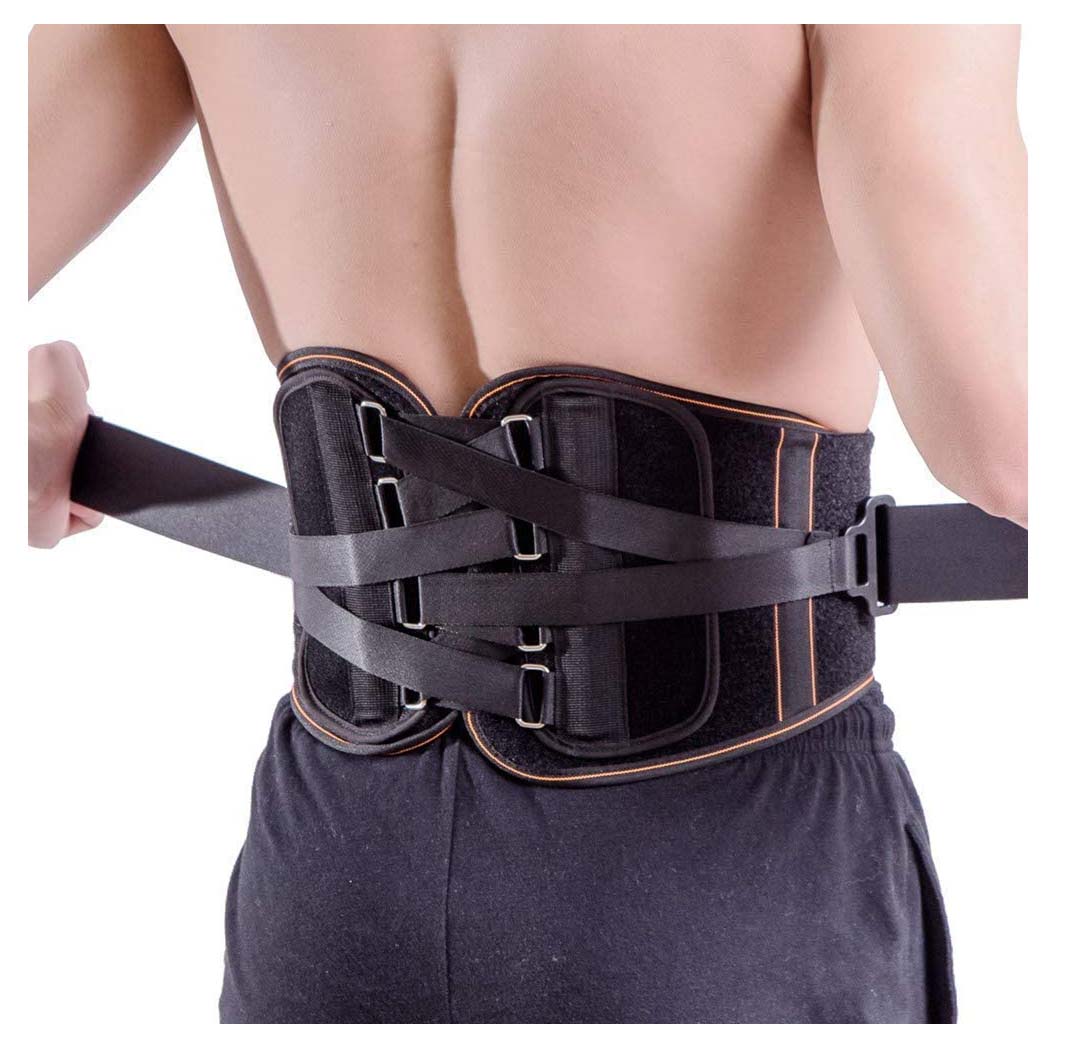In tennis, people move around a lot. If you play tennis and need a back brace, you should get one as soon as possible.
There aren't many best back brace for tennis players on the market. You need to know what kind of back support will best protect your back.
The lower back is the part of the back that gets hurt the most when you play tennis. The lower back or spine is called the lumbar region so you will need a back brace for the lumbar region.
A lumbar back brace keeps your lower back from making sudden, painful movements. There are a lot of quick moves in tennis that can put stress on your back.
I did some research and found a back brace that supports your lower back and protects the lumbar area of your spine.
This back brace can help you move around while keeping your back stable. The pressure will protect your back that the back support puts on it, making it stable. It squeezes your midsection to ensure it's not moving painfully.
Top 5 Back Brace For Tennis
Picture | Name | Ratings | Price |
|---|---|---|---|
(3530 Reviews) | |||
(27698 Reviews) | |||
(929 Reviews) | |||
(3320 Reviews) | |||
(43127Reviews) |
Pros
- Trains the muscles in your upper back
Cons
- Made only for the upper back
- People with longer torsos may not get as much out of it
We chose this FlexGuard back brace because it has parts of both an upper and lower back brace and a posture corrector. You can choose from four different sizes, and the straps around your waist and upper back are adjustable to get the perfect fit for your needs.
Like the straps on a backpack, the upper shoulder straps pull your shoulders back to help you stand up straighter, while metal braces support your lower back.
Material: Neoprene | Part of Back it Up Upper back | Can't be washed in a machine:
Pros
- Price
- Lowers the pressure on the discs in the lower back. Helps with heavy lifting
Cons
- Move around less
- Velcro may snag fabric
There are a lot of expensive back braces on the market, but the Mueller Lumbar Support Back Brace is a good choice if you want something more straightforward and cheaper to help support your lower back when lifting heavy things at work or the gym. This back brace goes around your waist, giving your lower back and stomach full support.
This back brace is made of breathable materials and fully adjustable to support and compress your lower back all day. It also has a lumbar pad that can be taken off.
Plastic held together with Velcro; part of Back it Lower and lumbar for heavy lifting | Yes, it can be washed in a machine
Pros
- Tourmaline magnets are built-in to improve blood flow
- Support can be adjusted thanks to the two outer elastic tension straps
Cons
- Confusing sizing
This back brace gives your lower back more lumbar support and has two Velcro straps on each side of the body to get the right compression fit. This belt is made to help support your back, ease back pain, and even improve your posture.
The belt is more expansive than many other back supports so that it can cover a broader range. It comes in sizes medium, large, and 2x-large, so you can choose the one that fits you best.
Sixty percent of the material is Neoprene, 20 percent is Nylon, 10 percent is elastic cotton, and 10 percent is Velcro. Lower/lumbar | Washable in a machine: yes
Pros
- The Pulley system lets you adjust the support to your needs
- The fabric can be taken off and washed
- fixes a lack of alignment
Cons
- Move around less
- Not likely to fit people with short torsos
Several back braces have a solid piece of material, rigid plastic, or metal spread across the back and lower spine. This can pressure the spine and sciatic nerve, which some people might find comfortable.
But this back supports is made to keep the spine from getting pinched or pressed. Using a pulley system, like shoelaces, the design can be pulled and tightened on both sides of your body to support your back without putting pressure on the spine. By limiting contact with the spine, this brace may also help treat leg pain caused by problems with the spine, such as Sciatica.
Mesh makes up part of Back it Up. Lower/lumbar | Washable in a machine: yes
Pros
- It helps ease the pain of a herniated disc
- Adjustable
- Mesh material that lets air in
Cons
- Metal supports can break through material.
- Confusing sizing
The spine is made up of bones called vertebrae that are separated by jelly-like discs. This lets you bend and stretch without the vertebrae touching or scraping against each other. But as we age or do hard work with our backs, these discs can shrink or become more fragile, making them more likely to get pinched or even break. This is called a "herniated disc," which can cause pain.
The Sparthos Breathable Back Brace may help lower the risk of a herniated disc. This back brace is made to let air in and has a lumbar pad that you can take off to give your spine a little more support. It also has stiff supports to keep the belt from rolling or losing its tight fit around your middle.
Material: Polyester mesh with metal supports that lets air pass through.
Part of Back it Lower/lumbar | Washable in a machine: yes
Why do you wear a back brace for tennis?
You wear a back brace to keep your back from getting hurt. If you want to know if you need a back brace, you might.
Here are some reasons you might need a back support when you play tennis. This sport needs a lot of flexibility and stretching, so taking care of your back and spinal cord is essential.
After getting hurt
An injury can stop you in your tracks and make it hard to play. You can't play as well as you could if specific movements hurt. A treatment suggested by a doctor is needed. If the doctor says it's okay, the next thing you should do is wear a back brace.
With a back brace, you won't be able to move in ways that could worsen your injury. For example, a back brace will ensure that your spine is stable if you have a lumbar injury.
Medical conditions
Some health problems can make it hard for you to move around. With all the sudden stops, twists, bend, and other movements in tennis, it can be hard to avoid pain.
Your game can be significantly hurt by joint inflammation, back problems, and deformities. When you swing the racket, your back and shoulders have to move. Depending on a person's health, running and swinging to hit a tennis ball can cause much pain.
By putting pressure on your core, a back support can help take the stress off your body from moving. This will protect the spine, the central part of the body that moves.
Protection
Some people wear back braces to protect their backs. A back brace can protect your back so that you don't feel pain when you move quickly. Weak joints can hurt a lot when you stop suddenly.
People who want to stay active as they age often have weak joints. It's mostly worn and torn from being active for years. A back support can help keep the pain down when making awkward moves in the game.
How does a back support work?
A back brace helps by putting pressure on your middle. This pressure will protect your back because it will limit how much you can move.
Even though you won't be able to move as freely, you can still be flexible if you wear the right back brace.
The back support keeps your back stable by keeping your spine in place. The pressure will help the spine hold up the upper body's weight. The spine naturally supports the upper body's weight and helps keep balance. When a back brace is worn, it takes this job away from the spine.
When you have back pain, the muscles in your back can get very sore. This can happen from too much stress and use. When someone has lower back pain, their muscles naturally help guide the lower back into safer positions. This can make the muscles shorter over time.
When pressure is put on the muscles, the back brace keeps them safe. It relaxes the muscles and almost makes them feel like they aren't there. This is why some say that as soon as they put their back brace on, they feel better immediately.
Nerve pain can sometimes cause shooting pain in certain places. Most of the time, this pain is caused by a movement that irritates a painful nerve. You can avoid moving in the wrong direction by stabilizing your torso with a back support.
Do Back Braces Help?
Why a tennis player should wear a back support
You'll have good support while moving around
This can help you move in a lot of ways without hurting. Movements like:
- Movements like:
- Twisting
- Jumping
- Using the tennis racket
- Squatting, low Lunging, And more
Wearing a brace for this kind of sport, in which you need to move around a lot, can help you a lot. You will be able to move in all of your usual ways when you perform.
It's hard to stay in shape when you're hurting
No matter how hard you try, the pain will force you to change how you move to try not to feel it. This can mess up your form and your game as a whole.
Putting on a back brace can help you keep your shape. It can help you keep your shape by stabilizing your torso, which is the center of all your movements. If you don't feel pain when you move, it's easier to do better than when you were hurt.
It can also help you get over any soreness or pain you might feel after a tennis game. He can help you get through your daily life and not dwell on your pain.
You'll feel safe
When you wear a back support, you will feel safe and secure. It can be dangerous not to pay full attention to pain, especially in the spine.
Our bodies will naturally go where the pain is and try to find ways to make it feel better. This will make you less active than you'd like, hurting your game. If your back hurts and you want to play tennis at your best, you need a back brace.
A back brace will hold your back in place and put pressure on your torso, which will help ease any pain you feel when you move.
You will feel at ease
It's hard to be comfortable with someone who is a pain. He will feel a lot of pain from the places that bother him. If you are in pain from playing tennis, it could be because you are making moves that your body is already used to.
If you are used to doing these things but are in pain while doing them, your body needs help to do these things. A back brace will make you feel better and give you the needed comfort. For a tennis player, the right-back support will let you be flexible but still stiff in some places.
Important Parts of a Back Brace
Many flexible and stiff lumbar orthoses are worn and put on in the same way. They also have the same few key parts, which are:

- The two "wings," or sides, of the brace, are made of a flexible or strong material that goes around the chest and joins over the belly or sides. In some cases, these wings may have extra parts that provide support and prevent movement at the sides of the body, such as extra panels in stiff braces or vertical metal or plastic stays in flexible braces.
- Rigid and semi-rigid back braces have a stiff back panel, usually made of hard moulded plastic, to keep the back in a healthy position. Most braces for healing after surgery have a hard back panel with a hole over the spine. This keeps the surgical wound from getting irritated.
- A strong front panel presses down on the stomach. Most of the time, the front panel is made up of two Velcro panels that meet and are used to close and fix the brace. Sometimes, an extra front panel is included and is put into one of the wings.
- Some way to make smaller and more exact changes to the brace. Many braces have a cord and a pull tab on each side that can be used to make small changes.
- Some brace types may look and work differently. For details on how the brace works and what it is made of, check the directions that came with it or ask the doctor who gave it to you.
How to Choose the Right Size
The size of your back brace is significant if you want it to fit well. Most back braces run small, so you should always buy one size bigger than your waist size.
To get your measurements, all you need is a measuring tape and a friend or family member to help you measure your waist, or you can do it yourself.
Many customers talk about how big their backward were when they bought them. Most of them tell you to buy one size bigger. So you can see what I mean, here is a quick size chart.
Size Guide for Back Braces:
Small (27" to 35") – Get a medium
Medium (35" to 43") – Get a large
Large (43"–51") is the tallest size.
Find out what size you should get by taking your measurements.
This is important because if you get a back brace that is too big for your body, it won't put enough pressure on your torso to protect your back.
If you buy a back brace that is too small for your body, it could make it hard for you to breathe or cause other health problems.
Follow the guidelines on the sizing chart to choose the right size back brace, and you'll be fine.




